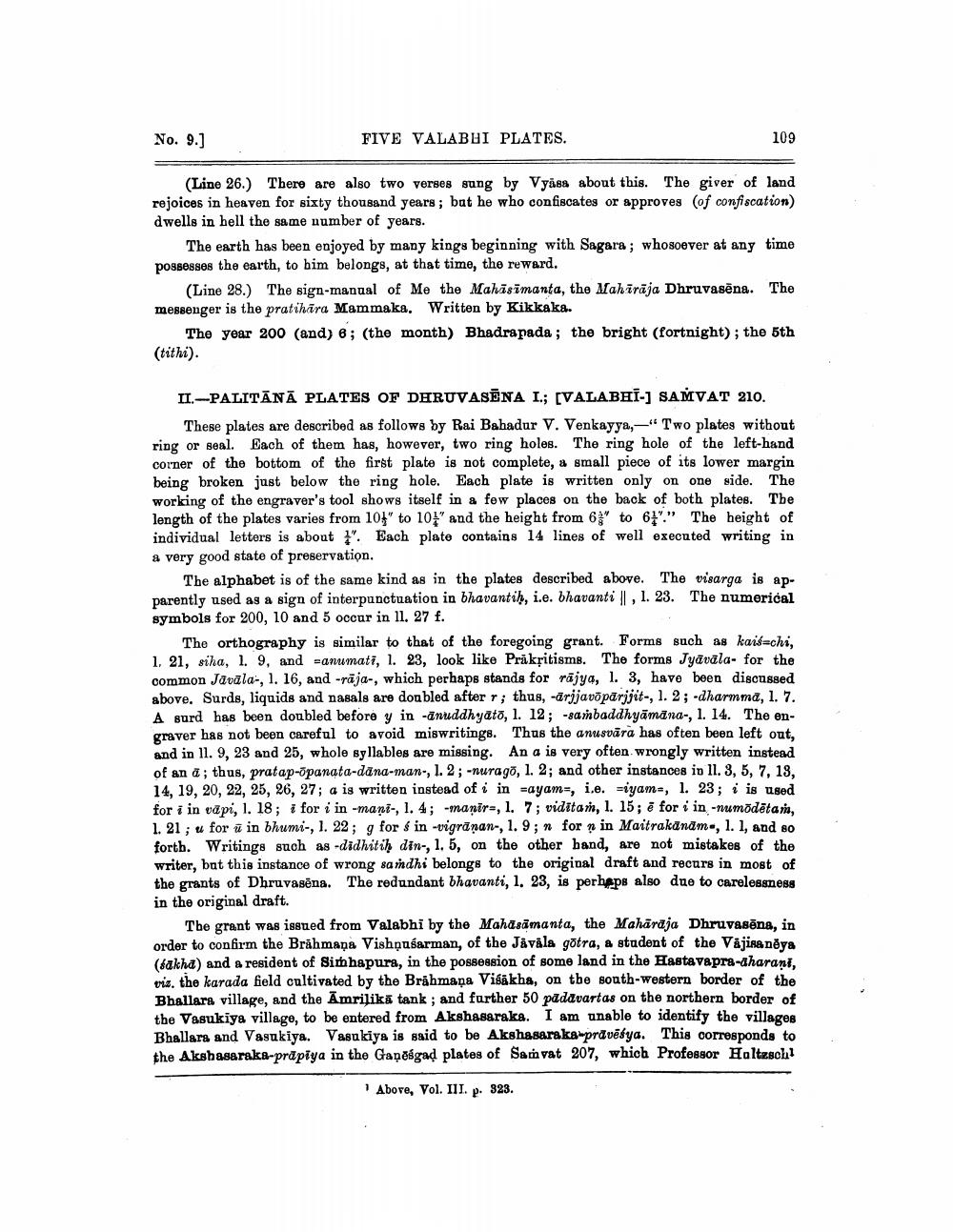________________
No. 9.]
FIVE VALABHI PLATES.
109
(Line 26.) There are also two verses sung by Vyass about this. The giver of land rejoices in heaven for sixty thousand years; bat he who confiscates or approves of confiscation) dwells in hell the same number of years.
The earth has been enjoyed by many kings beginning with Sagara; whosoever at any time possesses the earth, to bim belongs, at that time, the reward.
(Line 28.) The sign-manual of Me the Mahasimanta, the Mahiraja Dhruvasēna. The messenger is the pratihira Mammaka. Written by Kikkaka.
The year 200 (and) 6; (the month) Bhadrapada ; the bright (fortnight); the 5th (tithi).
II.-PALITĀNĀ PLATES OF DHRUVASĒNA I.; [VALABHI-) SAMVAT 210.
These plates are described as follows by Rai Bahadur V. Venkayya," Two plates without ring or seal. Each of them has, however, two ring holes. The ring hole of the left-hand corner of the bottom of the first plate is not complete, a small piece of its lower margin being broken just below the ring hole. Each plate is written only on one side. The working of the engraver's tool shows itself in a few places on the back of both plates. The length of the plates varies from 101" to 101" and the height from 6% to 67%." The height of individual letters is about ". Each plate contains 14 lines of well executed writing in a very good state of preservation.
The alphabet is of the same kind as in the plates described above. The visarga is apparently used as a sign of interpunctuation in bhavantih, i.e. bhavanti || 1. 23. The numerical symbols for 200, 10 and 5 occur in 1l. 27 f.
The orthography is similar to that of the foregoing grant. Forms such as kais-chi, 1. 21, siha, l. 9, and -anumati, 1. 23, look like Praksitisms. The forms Jyavala- for the common Javala-, 1. 16, and -räja-, which perhaps stands for räjya, I. 3, have been discussed above. Surds, liquids and nasals are doubled after r; thus, -drijavöparijit-, 1. 2; -dharmma, 1. 7. A gurd has been doubled before y in -īnuddhyato, l. 12; -8ambaddhyāmana-, 1. 14. The engraver has not been careful to avoid miswritings. Thus the anusvāra has often been left out, and in 11. 9, 23 and 25, whole syllables are missing. An a is very often wrongly written instead of an a; thus, pratap-opanata-dana-man-, 1. 2; -nurago, 1. 2; and other instances iv 11. 3, 5, 7, 13, 14, 19, 20, 22, 25, 26, 27; a is written instead of i in =ayam, i.e. riyama, 1. 23; i is used for i in väpi, 1. 18; i for i in -mani-, l. 4; -manir, 1. 7; viditan, 1. 15; è for i in-numodētan, 1. 21; u for u in bhumi-, 1. 22; g for f in -vigrānan-, 1. 9;n for ^ in Maitrakandm., 1. 1, and so forth. Writings such as -didhitih din., 1.5, on the other hand, are not mistakes of the writer, but this instance of wrong samdhi belongs to the original draft and recurs in most of the grants of Dhruvasëns. The redundant bhavanti, 1. 23, is perhaps also due to carelessness in the original draft.
The grant was issued from Valabhi by the Mahasamanta, the Maharaja Dhruvasēna, in order to confirm the Brahmana Vishạnsarman, of the Jåväla gotra, a student of the Vajina něya (bakha) and a resident of Simhapura, in the possession of some land in the Hastavapra-dharani, pis, the karada field cultivated by the Brāhmaṇa Visakha, on the south-western border of the Bhallara village, and the Amrilikā tank; and further 50 pdddvartas on the northern border of the Vasukiya village, to be entered from Akshasaraka. I am unable to identify the villages Bhallara and Vasukiya. Vasukiya is said to be Akshasaraka prdvēsya. This corresponds to the Akshasaraka-prapiya in the Gaņošgad plates of Samvat 207, which Professor Holtzsch
Above, Vol. III. p. 323.




